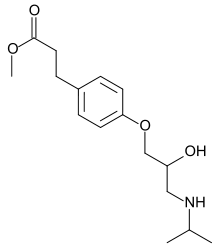Esmolol
Esmolol (trade name Brevibloc) is a cardioselective beta1 receptor blocker with rapid onset,[1] a very short duration of action, and no significant intrinsic sympathomimetic or membrane stabilising activity at therapeutic dosages.
 | |
| Clinical data | |
|---|---|
| AHFS/Drugs.com | Monograph |
| Pregnancy category | |
| Routes of administration | iv |
| ATC code | |
| Pharmacokinetic data | |
| Bioavailability | - |
| Protein binding | 60% |
| Metabolism | Erythrocytic |
| Elimination half-life | 9 minutes |
| Excretion | Renal |
| Identifiers | |
| |
| CAS Number | |
| PubChem CID | |
| IUPHAR/BPS | |
| DrugBank | |
| ChemSpider | |
| UNII | |
| KEGG | |
| ChEBI | |
| ChEMBL | |
| CompTox Dashboard (EPA) | |
| Chemical and physical data | |
| Formula | C16H25NO4 |
| Molar mass | 295.379 g·mol−1 |
| 3D model (JSmol) | |
| |
| |
| | |
It is a class II antiarrhythmic.[2] Esmolol decreases the force and rate of heart contractions by blocking beta-adrenergic receptors of the sympathetic nervous system, which are found in the heart and other organs of the body. Esmolol prevents the action of two naturally occurring substances: epinephrine and norepinephrine.[3]
It was patented in 1980 and approved for medical use in 1987.[4]
Medical uses
To terminate supraventricular tachycardia,
Episodic atrial fibrillation or flutter,
Arrhythmia during anaesthesia,
To reduce HR and BP during and after cardiac surgery, and
In early treatment of myocardial infarction.
Esmolol is also used in blunting the hemodynamic response to laryngoscopy and intubation.[5]
Dosing
A loading dose of 0.5 mg/kg is given followed by 0.05–0.2 mg/kg/min infusion.
Metabolism
Esmolol is considered a soft drug,[6] one that is rapidly metabolized to an inactive form. Esmolol is rapidly metabolized by hydrolysis of the ester linkage, chiefly by the esterases in the cytosol of red blood cells and not by plasma cholinesterases or red cell membrane acetylcholinesterase. Total body clearance in man was found to be about 20 L/kg/hr, which is greater than cardiac output; thus the metabolism of esmolol is not limited by the rate of blood flow to metabolizing tissues such as the liver or affected by hepatic or renal blood flow. Esmolol's short duration of action is based on the ester-methyl side chain which allows for quick hydrolysis. Esmolol's structure is reflected in its name, es-molol as in ester-methyl. Plasma cholinesterases and red cell membrane acetylcholinesterase do not have any action. This metabolism results in the formation of a free acid and methanol. The amount of methanol produced is similar to endogenous methanol production. Esmolol has a rapid distribution half-life of about 2 minutes and an elimination half-life of about 9 minutes.
References
- Deng CY, Lin SG, Zhang WC, Kuang SJ, Qian WM, Wu SL, et al. (December 2006). "Esmolol inhibits Na+ current in rat ventricular myocytes". Methods and Findings in Experimental and Clinical Pharmacology. 28 (10): 697–702. doi:10.1358/mf.2006.28.10.1037498. PMID 17235414.
- Jaillon P, Drici M (December 1989). "Recent antiarrhythmic drugs". The American Journal of Cardiology. 64 (20): 65J–69J. doi:10.1016/0002-9149(89)91203-4. PMID 2688391.
- Tripathi KD. "Antiadrenergic Drugs and Drugs for Glaucoma". Essentials of Medical Pharmacology (7th ed.). p. 149.
- Fischer J, Ganellin CR (2006). Analogue-based Drug Discovery. John Wiley & Sons. p. 462. ISBN 978-3-527-60749-5.
- Sharma S, Suthar OP, Tak ML, Thanvi A, Paliwal N, Karnawat R (2018). "Comparison of Esmolol and Dexmedetomidine for Suppression of Hemodynamic Response to Laryngoscopy and Endotracheal Intubation in Adult Patients Undergoing Elective General Surgery: A Prospective, Randomized Controlled Double-blinded Study". Anesthesia: Essays and Researches. 12 (1): 262–266. doi:10.4103/aer.AER_226_17. PMC 5872877. PMID 29628593.
- Bodor N, Buchwald P (2000). "Soft drug design: General principles and recent applications". Medicinal Research Reviews. 20 (1): 58–101. doi:10.1002/(SICI)1098-1128(200001)20:1<58::AID-MED3>3.0.CO;2-X. PMID 10608921.
External links
- "Brevibloc". RxList Inc.